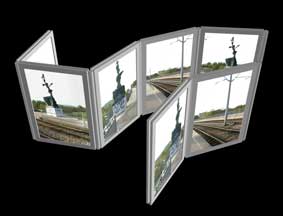

Polyptych © LFKs / Bernd Lintermann
It is not uncommon for video artists to adopt a multi-panel form for their compositions, substituting video screens for wooden panels and moving image for painting. Polyptych makes an entirely different proposition.
A key characteristic of the polyptych was its ability to fold to facilitate transport. This folding characteristic becomes integral to Polyptych: it is the opening and closing of the panels which drives the evolution of the video content. A unique relationship between spectator and art work, emphasizing haptic cognition and tactile interaction, allows spatial reconfigurations to define the work's evolution.
The history of art is the most passionate expression of the history of technique. New techniques enter the artistic domain not only by becoming available to artists, but more profoundly by requiring that art transform itself in order to remain both a description and a reflection of human society, situated both at its origin and at its destination. Art manifests the radical continuity of society, and yet never ceases nor delays in renewing the forms it gives to our understanding of our own metamorphoses.
The major polyptych altarpieces of the late Middle Ages in Europe provide an excellent example of this relationship, combining an artistic mastery gained over centuries with the rapid and dramatic technical progress which catalyzed the Renaissance. The innovation of painted mobile panels was to enable an artistic practice based on the variation of relationships between multiple images. In a world whose movement had begun accelerating, technical advances granted art the visual language necessary to represent this dramatic movement.
Polyptych connects multiple plasma screens to form eight mobile leaves whose relative positions are altered by spectators, triggering reconfigurations of the images seen on the screens, their composition, their meaning and their reading. The Polyptych project results from research into the current state of interactive image and sound technology and aims both to fuel this technical innovation and to honour the great and venerable aesthetic tradition which it evokes and revisits.
Because of our double desire to apply innovations both of the present, which give the project its form, and of the past, which provide its meaning, we propose that any and all elements of Polyptych which are not required to be new will clearly refer to the repertory of polyptych panel painting. Accordingly, the imagery used in Polyptych shall adhere to formal principles of portraiture and landscape bequeathed to us by the Sixteenth Century, when polyptych altarpieces were at their height.
Polyptych is a Jean Michel Bruyere / LFKs work in progress in collaboration with Bernd Lintermann, director of Institute for Visual Media at ZKM, Karlrsuhe (DE).
